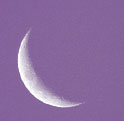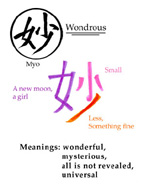
The word that is pronounced Myo by Nichiren Buddhists is composed of two Chinese root characters (for a better view, see page 2, upper right hand corner of the Japanese Gongyo book). The character to the right is Shao. The character to the left is Nu.
|
|
|
|
|
|
It corresponds to the Sanskrit word Sad, meaning "perfectly endowed" or "complete" round (Hokke) teaching (kyo).
Why is "mysterious"
(mystic) a "young girl"? The answer lies in the nu character. The
brush strokes that compose nu outline the image of the new moon.
Look inside the brush strokes to see it.

The moon is
at first a slender crescent that grows into full roundness, expressing
the maturity of a young girl growing into a full (pregnant) woman.
The new moon is like a young girl. The full moon is a mature woman. The moon is by extension an expression of the cycle of birth and death, therefore "universal." The new moon only partially illuminates the full moon meaning "all has not been revealed" and is therefore "mysterious."
The moon illuminates the darkness as does hope (myo). Hope opens the doors that are "difficult to enter" in the Hoben Pon of the Lotus Sutra. The path illuminated by myo is medicine for all living things.
"Just as the moon is reflected in the water the moment it appears from behind the eastern mountains" (from the Major Writings, Vol. 3, p. 306), our world is illuminated by introducing all to Myo, the First Buddha of the Lotus Sutra.
![]()
 |
|
------------
Sources:
- Chinese Characters: Their origin, etymology, history, classification, and signification, by L. Weiger (1965) Paragon Books.
- The smaller Chinese characters (at top) are all from http://zhongwen.com/, the premiere Internet source for Chinese characters.
- The colored characters in the Diagram (above) were drawn by Angela Pun and Elizabeth Wang, without whose help this project would have faltered.